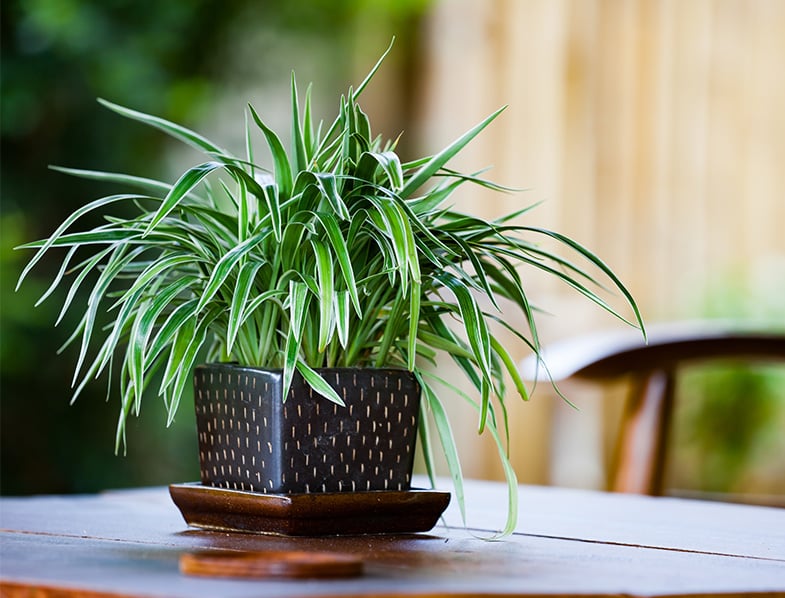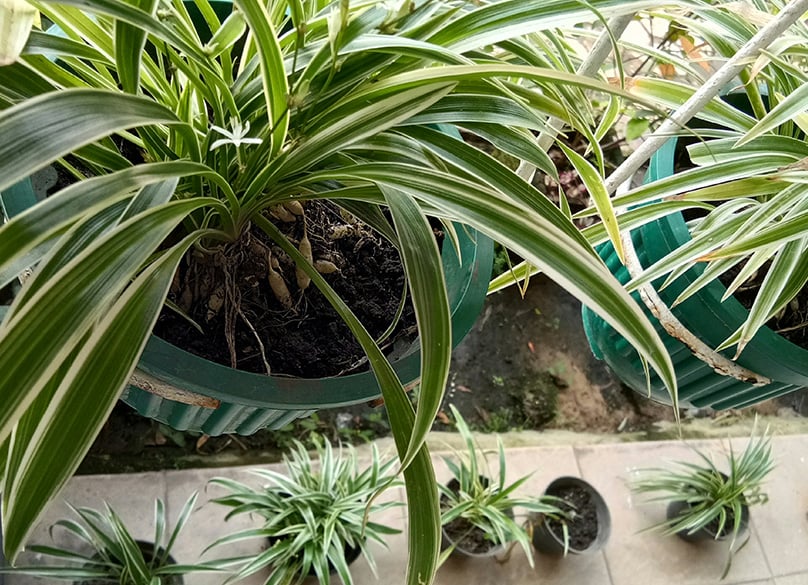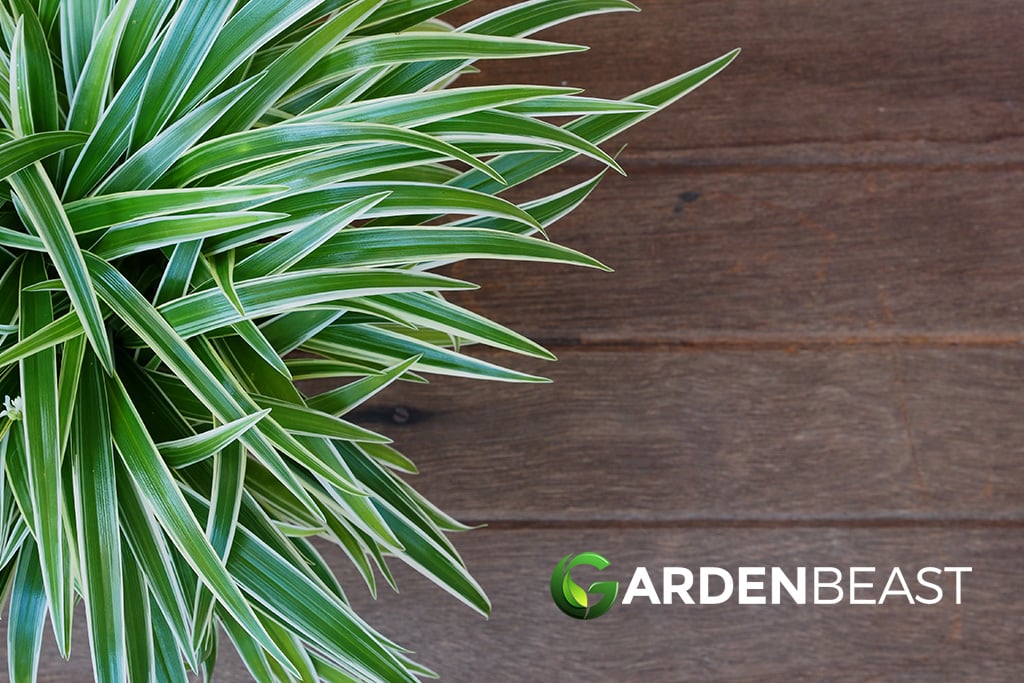If you’re looking for a houseplant that’s easy to grow indoors and adds value to your indoor garden, then consider a spider plant for your addition.
The spider plant gets its name from its many leaves that sprawl out to the sides of the plant, giving the impression of a spider standing with its legs sprawled out.
These plants produce rosettes of thin and long leaves that are either solid green or have white variegation. Spider plants were a household favorite in Victorian times, and they look fantastic when hanging in a plant basket.
Spider plants are part of a family of plants known for “air-scrubbing” properties. Leave a spider plant in the room, and it cleans the air of dangerous toxins like formaldehyde, which is present in new construction and freshly painted homes, leaving that chemical smell behind.
Spider plants also reproduce readily, allowing you to plant the “spiderettes” that grow from the mother plant. Here’s everything you need to know about planting and caring for spider plants.
Types of Spider Plants
Spider plants come in dozens of different varieties. However, the most common types of spider plants you’ll find at your local nursery or big-box retailer include varieties with solid green leaves or green leaves with white variegation. Common spider plants have a single white stripe running down the center of the leaf.
Variegated options are popular among indoor gardeners, as the variegation adds a dash of eye-pleasing color and texture to the plant that you don’t get with solid-leaf varieties.

Where to Plant Spider Plants
Spider plants do well outdoors in warm climates. If you live in USDA zones 9 to 11, then spider plants will last all year outdoors, and you won’t have to bring them indoors unless temperatures fall below 50F.
You must choose a spot in your home or garden that receives indirect sunlight. Direct sunlight causes the foliage of the spider plant to whiter and turns brown at the tips. The ideal spot for your spider plant is in a well-lit bathroom, as the plant will absorb all the moisture it needs from the air after you finish a steamy shower.
If you’re planting in the garden, make sure you choose an area of the yard with loose, loamy soil that drains well. Spider plants don’t need much in the way of fertilizer, and you can get away with one fertilizing session in early spring.
Spider plants are also excellent options for hanging in baskets, as the leaves hang over the sides, providing a classy look to your patio. Planting spider plants indoors in containers is also an option, but make sure the pot or container has adequate drainage holes to prevent root rot from wet roots.
- Reverse Ocean Spider plant in 4 inch pot
- Easy to care: Prefers bright, indirect light or artificial light
- Keep evenly moist, not wet or dry
- Air purifying house plant / great for indoor environment
- Homegrown by jmbamboo
- Great gift for the home, apartment, office, dorm or den
- Prefers bright, indirect light or artificial light
- Keep evenly moist, not wet or dry 3 pack.
- Keep evenly moist, not wet or dry
Last update on 2024-01-21 / Affiliate links / Images from Amazon Product Advertising API
How to Plant Spider Plants
When planting your spider plants in pots, make sure that you use a well-draining, soil-based potting mixture. Spider plants prefer even moisture, and they don’t enjoy being dry for extended periods, and they hate getting their “feet wet.”
Wet feet is a condition where the soil does not drain properly. As a result, the plant’s roots are continually in overly moist soil, inducing the start of root rot. Other pathogens might also take an interest in your plant, spreading disease throughout your indoor garden.
Place the root ball below the surface of the soil and press down lightly to compact the roots. Water the plant to reduce transplant shock, and then let the soil dry naturally over a few days before watering again.
Spider plants that get too much water start to develop squishy leaves. If you notice this occurrence, then let the plant dry out for a week before assessing the plant’s water needs.
Most spider plants grow to heights of around 12-inches, with cascading leaves that fall over the sides of the pot as the spider plant grows.

Caring for Your Spider Plants
If you’re having trouble identifying the best time to water your spider plants, use the finger test. Dig your fingertip into the soil, and note the moisture level. If the soil feels wet, then leave it for another day. If the soil feels dry, then it’s time to water your spider plant.
Spider plants absorb moisture from the air through the leaves. Therefore, setting up a humidifier near your spider plant will keep it looking its best all year. Spider plants are also sensitive to salts and minerals in the water. If you feed your plant with regular tap water, it may result in the scarring of the plant’s leaves.
We recommend that you water your spider plants with distilled or mineral water for the best results. Spider plants are reasonably hardy, and they have good drought-resistance. However, we recommend that you never let your spider plant dry out entirely, and keep an even consistency to the moisture in the soil.
Spider plants thrive in temperatures between 55 and 80°F, making them the ideal choice for an indoor houseplant. If your spider plant outgrows its pot, replant it in the early springtime, and then feed it a month later using a liquid-based fertilizer to encourage new growth.
You’ll know it’s time to re-pot your spider plant when you notice roots growing out of the drainage holes on the bottom of the pot.
In some circumstances, spider plants start to produce small flowers. If your plant is root-bound in a small pot, then it will fail to flower until it has enough room for the roots in the growing medium. While spider plants do enjoy being root-bound, overdoing it could cause the roots to expand and break the pot.
Pests and Diseases Affecting Spider Plants
Spider plants that live indoors rarely present owners with any issues regarding pests and diseases.
However, spider plants are susceptible to root rot., and overwatering your plants may cause this occurrence.
- Spider plants are also prone to developing tip-burn due to low humidity, dry soil, or buildup of chemicals and salts found in public drinking water supplies. Always ensure that the soil in the pot remains consistently damp, and avoid overwatering your plants.
- Cut off any of the brown tips as they occur to prevent the burn from spreading further down the leaf. Remove any burned leaves that are beyond salvaging. In most cases, your spider plant will recover, and the leaves will turn back to the original color with time and care.
- In some cases, you might find that you can scrape off the browning on the leaves using your finger nail. However, be careful not to damage the leaves when scraping, as this could cause the foliage to die back entirely.
If you’re planting your spider plants in the garden, then we suggest you keep an eye on them during the peak of summer. If your spider plant sits in direct sunlight, it will wither away and die in a matter of days. Choose your planting site carefully, and make sure you account for seasonal changes in sun direction in your yard.
Gardeners planting outdoors also need to check their plants for signs of mealybugs and scale that could kill the plant. If you do find mealy bugs, use an organic pesticide to kill the bugs.
Planting Spiderettes
As the daylight hours start to extend in the spring, your spider plant might begin to produce “spiderettes.”
Spiderettes are tiny little spider plants growing around the base of the plant. However, only mature spider plants will start creating spiderettes, and if the growing conditions are not ideal, then the plant will fail to produce offspring.
If you’re one of the gardeners that’s lucky enough to have a flowering mature spider plant; then you can harvest the spiderettes and replant them in a separate container to add to your garden. The best way to root spiderettes is to leave them attached to the mother plant while they establish roots.
Select a spiderettes, and plant it in a pot next to the mother. Keep the soil wet, and when the plant establishes roots, you can cut it away entirely from the mother, bury the roots, and start growing a brand new spider plant!
Another method for propagating your spider plants is to cut off a plantlet, then place it in soil, and then water generously. We recommend that you plant the spiderette in a small material bag. This medium helps aerate the soil, allowing your spiderettes to root much faster. Place the bag in an indirectly sunny spot, and wait for the plant to root.
After rooting, remove the plant from the bag and plant it in a separate container. Water after planting, and then grow as you would a standard spider plant. For the best results from your transplant, let the spider plant reach 2-inches in foliage diameter before you remove it from the material bag for transplanting.
Recommended Spider Plant Varieties
Spider plants are native to South Africa, so they enjoy warm climates with moderate rainfall. The variegated species are the most popular types found in indoor gardens.
We recommend the following varieties to newbie spider plant owners.
- “Variegatum” – This variety features a white stripe running down the edges of the green leaves.
- “Vittatum” – This variety has a single white stripe running down the center of the leaves.
You also get solid-green leaf varieties, but they are less prevalent than variegated varieties.




1 Comment
thankyou thankyou
i like t5his plant it is something hard to kill
in got one with a lot of stuffetts hanging on it
and going to start some more i can do this, amen –
happy blessings — https://bobknab.blogspot.com/